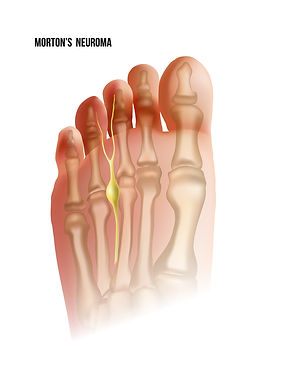Lochthorn Medical Centre. Edinburgh Road. Heathhall. Dumfries. DG1 1TR.
Tel: 07597694581
Tel: 07597694581


Common MSK conditions
MSK conditions of the foot, ankle and knee are very common and lead to a large number of conditions. Below there are a few of the most common foot problems.


Plantar Fasciopathy
More commonly known as Plantar fasciitis which is a condition in which there is persistent pain associated with degeneration of the plantar fascia as a result of repetitive microtears in the contracted fascia. Pain is felt mostly on the bottom of your foot, around your heel and arch. It is a common condition, especially in people aged 40–60 years and can affect people who are active and non-active equally.
It is painful when you first stand up after periods of rest, then reduces after moderate movement, then reoccur after long periods of standing or walking.


Tendinopathies
The function of a tendon is to connect muscle tissue to bone. Tendonitis is when a tendon swells and becomes inflamed after a recent tendon injury it may be acute or chronic.
Tendinosis is a more chronic condition. The damaged tendon has microscopic scarred fibres which are often hard, thickened and rubbery in appearance It is usually a result degeneration caused over time.
Tendinopathy is a more general term than tendonitis and tendinosis and just means tendon injury, without specifying the type of injury.
The Achilles tendon is the largest and strongest tendon in the body and attaches the calf muscle to the heel. Injury to this tendon is often debilitating, with muscle stiffness, burning, crackling of the involved joints, pain and inflammation.
Morton's Neuroma
Morton's neuroma is a painful condition that affects the ball of your foot, most commonly the area between your third and fourth toes. Morton's neuroma may feel as if you are standing on a pebble in your shoe or on a fold in your sock.
Morton's neuroma involves a thickening of the tissue around one of the nerves leading to your toes. This can cause a sharp, burning pain in the ball of your foot. You may have stinging, burning or numbness in the affected toes.
Bunions
A bunion, also known as ‘hallux valgus’, is a deformity of the big toe in which the big toe angles excessively towards the second toe and leads to a bony lump on the side of the foot. A large sac of fluid, known as a bursa, may also appear, and this may become inflamed and sore. Although Bunions may be genetic, poorly fitting footwear tends to aggravate the problem as tight or narrow footwear can squeeze the forefoot, crowding the toes together and exacerbating the underlying condition, causing pain and deformity of the joint. Bunions can also lead to corns and calluses developing.

Rheumatoid & Osteoarthritis
Rheumatoid arthritis is an autoimmune disease, which means your immune system attacks the cells in your joints by mistake, making the joints swollen, stiff and painful.
Over time, this can damage the joints, cartilage and nearby bone.
Osteoarthritis (OA) is the most common chronic joint condition. OA is also called wear-and-tear arthritis.
Arthritic conditions, which there are many forms often lead to joint deformity, pain and difficulty with correct fitting footwear.

Flat feet & High arched feet
High arched (Pes Cavus) feet are often genetic or caused by neurological conditions you were either born with or obtained through neurological changes through Diabetes. High arches result in more stress on the feet, which can lead to painful symptoms, and corns and calluses.
Flat feet (pes planus), is a deformity that occurs when the arch of the foot collapses and comes into complete or near-complete contact with the ground. Not everyone has problems with their flat feet but for some it may lead to midfoot, ankle, knee, hip and back pain.


